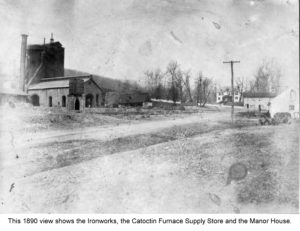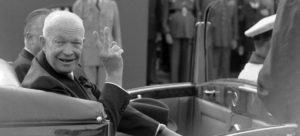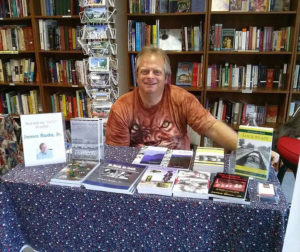A new serial fiction story for your enjoyment about the odd effects of grief.
Written by James Rada, Jr.
1: ANIMAL KILLER
Her own screams woke her from her nap. That’s how it always was for Betty Douglas. Sleep was a fleeting thing, if it came at all, and it was never a peaceful affair, just something she did to pull herself through to the next day.
Yet the next day was never any better than the one before it. More of the same emptiness. More of the same fears. More of the same pain.
Betty never left her property anymore because she would have to go past the end of the driveway and that was an evil place. A place where death was stronger than life, and it hurt her to see it. It reminded her of what Old Kiln Road had done to her son…her Peter.
Can an inanimate thing kill?
She had asked herself that question 10,000 times if she had asked it once. Around the 4,000th time, Betty began to think the answer was “yes.”
Old Kiln Road was evil. It was a murderer. In particular, the stretch of road that ran in front of her home. The road ran from Roddy Road, north, with a couple of hard turns to Motters Station Road. In all, it was about 2.5 miles long, with a few dozen homes along it and a lot of open space.
For as long as Betty could remember, there had always been a lot of roadkills on Old Kiln Road. Back when Betty used to like to sit on her front porch, she saw a dead animal almost every time she walked out her front door because most of them seemed to be along the stretch of road that ran in front of her property.
Rabbits, dogs, cats, possums, raccoons, and some unidentified remains. Still, she hadn’t ever thought it was anything more than the result of a losing battle between Mother Nature and modern technology.
The only thing Betty had thought was odd was how completely the dead animals decayed. She never had to take a shovel out to the road to bury the dead animals because they always seemed to disappear after a few days.
And there was never any smell. Oh, she’d seen the birds picking over the bones, and the flies swarming over the bodies. Then one day, she would come out, and the first corpse would have vanished, a brand new animal laying splattered on the road.
In all her years of porch-sitting, Betty had never seen an animal killed, only the remains. Then one overcast day, she saw it happen. Normally, she wouldn’t have been outside on such a dreary day, but the house was stifling hot because the air-conditioning needed a shot of freon. Her husband, Jack, had called the repairman the day before, trying to get him out to the house.
So, Betty had walked out onto the porch to get away from the heat. She sat down in her favorite chair, a wooden rocker Jack had bought her when she was pregnant with Peter. As she rocked back and forth, Betty watched the sparse traffic go back and forth on Old Kiln Road, a car every 10 minutes or so, if that much.
She wasn’t the only one watching either. On the other side of the two-lane road, a beautiful collie sat in the grass, its head swinging back and forth. The dog had to be someone’s pet. Betty wondered where the dog had come from and why it just sat watching the road. It looked as if it was waiting for something.
From the south, an unseen car engine roared as the driver picked up speed on the straight stretch of road. Betty’s house was close to one end of that stretch and the only one within a quarter mile.
Peter came to the door and said, “Mom, can I have a cookie?”
Betty looked over her shoulder. Peter was standing in the doorway, smiling that innocent way he had of grinning. Betty couldn’t resist him.
“Only two. And put the jar back when you’re done,” she said.
Peter went back inside the house, and Betty again turned her attention to the dog on the other side of the road. It was standing now and stretching as if it was preparing to cross the street.
“Don’t come now, puppy,” Betty muttered to herself. “Can’t you hear that car coming?”
The car was maintaining a good clip, probably going about 50 miles an hour. The collie watched it come. Betty was happy that the dog wouldn’t become roadkill. It was such a pretty dog.
Right before the car passed the dog, it suddenly jumped onto the road. The collie was too close to the car for it to slow down and let it pass. It happened so quickly, Betty only had time to open her mouth to yell. The truck hit the dog, knocking it to the ground and then catching the collie under the truck tires. The car slowed, but rather than stop, it sped up to get away from the scene of the accident.
Betty’s scream died in her throat as she just stared at the corpse. The dog had committed suicide. That’s the only way she could describe it, as she gaped at the mangled, bloody corpse.
Of course, Jack hadn’t believed her. She had told him the whole story when he came home from work that night. He had just muttered, “Stupid mutt,” and went off to watch the evening news. Peter, on the other hand, had asked her if he could have a collie for a pet.
Betty knew it was more than the fact that the dog was stupid. The collie had seen the car coming, and it had jumped in front of the car. That night, Betty sat out on the porch, staring at the corpse. The first scavengers, the birds, left near sunset, leaving the disfigured corpse laying on the road. By morning, other small scavengers would have come and picked over the dead collie.
Even as Betty watched, a raccoon crossed the street and stopped to smell the corpse. While it was chewing on the dead collie’s ear, a car along the road drove by and flattened the raccoon. Betty almost screamed.
She had lived in the house for seven years without ever seeing an animal killed on the road, and now she had seen two animals killed within half a day of each other.
She shook her head back and forth. Had the collie moved? No, it was dead. She had seen it killed. But the dog’s corpse was moving. It was sinking into the road as if it was a ship sinking in the ocean. How could that be? The asphalt was a solid surface.
Why hadn’t she ever noticed this before? No one had ever mentioned something this odd to her, but who actually watched the road? Peter was always playing in the backyard, and Jack was usually away at work. But it had happened. She had seen it. When she had slowed down enough to pay attention to things, she had finally noticed what had been happening right in front of her own home.
That night, Betty dreamed of Old Kiln Road as a giant beast. The road was actually a long, black tongue, leading into the dark throat of a sleeping beast. The tunnel of trees that shaded the road at the top of the hill formed the throat. And the beast was always hungry, even in its sleep. It was like an angler fish that dangled its bait to attract food. The road was the bait that lured other animals into the maw of the beast.


 The Chesapeake and Ohio Canal was the great national project that failed to live up the dream. It never reached its ultimate destination, which was not Cumberland, Maryland (where it wound up), or the Ohio River (as the name implies). The early vision of the canal planners was something far grander and longer, and it’s just one of the secrets of the C&O Canal.
The Chesapeake and Ohio Canal was the great national project that failed to live up the dream. It never reached its ultimate destination, which was not Cumberland, Maryland (where it wound up), or the Ohio River (as the name implies). The early vision of the canal planners was something far grander and longer, and it’s just one of the secrets of the C&O Canal.

